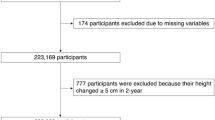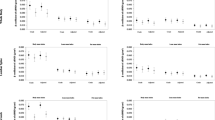Abstract
Introduction
The study aimed to clarify associations between height loss, bone loss and the quality of life (QOL) score among general inhabitants of Miyama, a rural Japanese community. This population-based epidemiological study was conducted in Miyama, a village located in a mountain area in Wakayama Prefecture, Japan.
Methods
A list of all inhabitants comprising 1,543 inhabitants (716 men, 827 women) born in this village between 1910–1949 was compiled. From the above whole cohort, a subcohort to measure bone mineral density (BMD) was recruited, consisting of 400 participants, divided into four groups of 50 men and 50 women each, and stratified into age decades by decade of birth-year (1910–1919, 1920–1929, 1930–1939 or 1940–1949). BMD measurement, physical measurements of height (cm) and body weight (kg) were taken, and body mass index (BMI; kg/m2) were calculated. BMD and anthropometric measurements were repeated on the same participants at 3, 7 and 10 years after baseline measurement (1993, 1997 and 2000).
Results and discussion
Among 299 of 400 participants, changes in height over 10 years for men in their 40s, 50s, 60s and 70s were −0.7 cm, −0.5 cm, −1.2 cm and −1.5 cm, respectively, compared with −0.7 cm, −1.4 cm, −2.1 cm and −3.7 cm in women, respectively. No significant relationships between change in height and rate of change in BMD at the lumbar spine and femoral neck after adjustment for age in men (lumbar spine, β = 0.058, standard error of the mean (SE) = 0.031, P = 0.501, R2 = 0.038; femoral neck, β = 0.100, SE = 0.038, P = 0.228, R2 = 0.121) were identified. By contrast, among women, a significant positive association was identified between height change and change rate of BMD at the lumbar spine after adjusting for age (β = 0.221, SE = 0.039, P = 0.012, R2 = 0.069), while no significant relationship was found between height change and change rate at the femoral neck (β = 0.107, SE = 0.039, P = 0.229, R2 = 0.048). No significant relationship was noted between vertebral fractures (VFx) and height at baseline in men and women (men: odds ratio (OR) 0.93, 95% confidence interval (CI) 0.81–1.05, P = 0.24; women: OR 0.97, 95% CI 0.87–1.08, P = 0.58) or between VFx and height loss (men: OR 1.31, 95% CI 1.00–1.71, P = 0.051; women: OR 1.20, 95% CI 0.94–1.53, P = 0.14). In both men and women, no significant relationship was identified between utility of the EuroQol EQ5D questionnaire and height at baseline (men: β = −0.148, SE = 0.003, P = 0.202, R2 = 0.076; women: β = 0.127, SE = 0.004, P = 0.235, R2 = 0.048), and height change (men: β = −0.078, SE = 0.008, P = 0.452, R2 = 0.065; women: β = 0.053, SE = 0.010, P = 0.608, R2 = 0.038).



Similar content being viewed by others
References
Hosoda Y, Fujiwara S (1992) The epidemiology of osteoporosis in Japan. J Epidemiol 2(suppl):205–213
Hashimoto T, Sakata K, Yoshimura N (1997) Epidemiology of osteoporosis in Japan. Osteoporos Int 7(suppl):99–102
Orimo H, Hashimoto T, Sakata K, Yoshimura N, Seino Y, Emi M, Hada A, Suzuki T, Hosoi T, Miyao M, Research Group for Risk Factors for Prevention of Osteoporosis, Longevity Science General Research Project, Ministry of Health and Welfare, (Director Orimo H) (1999) Results of the 3rd nation-wide survey of femoral neck fracture. Estimation of the number of new patients in 1997 and changes during the past 10-year period. Nihon Iji Shinpo (Japan Medical Journal) 3916:46–49 (in Japanese)
Yosihmura N, Suzuki T, Hosoi T, Orimo H (2005) Epidemiology of hip fracture in Japan: incidence and risk factors. J Bone Miner Metab 23:78–80
Wardlaw GM (1996) Putting body weight and osteoporosis into perspective. Am J Clin Nutr 63 (3 Suppl):433–436
Yoshimura N, Hashimoto T, Morioka S, Sakata K, Kasamatsu T, Cooper C (1998) Determinants of bone loss in a rural Japanese community. The Taiji Study. Osteoporos Int 8:604–610
Dennison E, Eastell R, Fall CH, Kellingray S, Wood PJ, Cooper C.(1999) Determinants of bone loss in elderly men and women: a prospective population-based study. Osteoporos Int 10:384–391
Wildner M, Peters A, Raghuvanshi VS, Hohnloser J, Siebert U (2003) Superiority of age and weight as variables in predicting osteoporosis in postmenopausal white women. Osteoporos Int 14:950–956
Nguyen TV, Sambrook PN, Eisman JA. (1998) Bone loss, physical activity, and weight change in elderly women: the Dubbo Osteoporosis Epidemiology Study. J Bone Miner Res 13:1458–1467
Tsunenari T, Yamada S, Kawakatsu M, Negishi H, Tsutsumi M (1995) Menopause-related changes in bone mineral density in Japanese women. A longitudinal study. Calcif Tissue Int 56:5–10
Meyer HE, Falch JA, O’Neill T, Tverdal A, Varlow J (1995) Height and body mass index in Oslo, Norway, compared to other regions of Europe: do they explain differences in the incidence of hip fracture? European Vertebral Osteoporosis Study Group. Bone 17:347–350
Nguyen TV, Center JR, Eisman JA (2000) Osteoporosis in elderly men and women: effects of dietary calcium, physical activity, and body mass index. J Bone Miner Res 15:322–331
Korpelainen R, Korpelainen J, Heikkinen J, Vaananen K, Keinanen-Kiukaanniemi S (2006) Lifelong risk factors for osteoporosis and fractures in elderly women with low body mass index-A population-based study. Bone 39:385–391
Kasamatsu T, Morioka S, Hashimoto T, Kinoshita H, Yamada H, Tamaki T (1991) Epidemiological study on bone mineral density of inhabitants in Miyama Village, Wakayama Prefecture (Part 1). Background of study population and sampling method. J Bone Miner Metabol 9(suppl):50–55
Kinoshita H, Danjoh S, Yamada H et al (1991) Epidemiological study on the bone mineral density of inhabitants in Miyama Village, Wakayama Prefecture (part II) Bone mineral density of the spine and proximal femur. J Bone Miner Metab 9(suppl):56–60
Yoshimura N, Kakimoto T, Nishioka M, Kishi T, Iwasaki H, Niwa T, Morioka S, Sakata T, Hashimoto T (1997) Evaluation of reproducibility of bone mineral density measured by dual energy X-ray absorptiometry (Lunar DPX-L). J Wakayama Medical Society 48:461–466
Yoshimura N, Kinoshita H, Danjoh S, Yamada H, Tamaki T, Morioka S, Kasamatsu T, Hashimoto T, Inoue T (1995) Prevalence of vertebral fractures in a rural Japanese population. J Epidemiology 5:171–175
EuroQol Group (1990) EuroQol: A new facility for the measurement of health-related quality of life. Health Policy 16:199–208
Ikeda S, Ikegami N (on behalf of the Japanese EuroQol Tariff Project) (1999) Health status in Japanese population, Results from Japanese EuroQol Study. Iryou-to-Kagaku 9:83–92 (in Japanese)
Yoshimura N, Kinoshita H, Danjoh S, Takijiri T, Morioka S, Kasamatsu T, Sakata K, Hashimoto T (2002) Bone loss at the lumbar spine and the proximal femur in a rural Japanese community, 1990–2000: The Miyama study. Osteoporos Int 13:803–808
Yoshimura N, Kinoshita H, Oka H, Muraki S, Mabuchi A, Kawaguchi H, Nakamura K (2006) Cumulative incidence and changes in prevalence of vertebral fractures in a rural Japanese community: a 10-year follow-up of the Miyama Cohort. Archives Osteoporosis, DOI 10.1007/s11657-006-0007-0
Yoshimura N (1996) Incidence of fast bone losers and factors affecting changes in bone mineral density - A cohort study in a rural Japanese community-. J Bone Miner Metab 14:171–177
Twiss JJ, Dillon AL, Konfrst JM, Stauffer J, Paulman A (2002) The relationship of actual height loss with health-seeking behaviors and risk factors in perimenopausal and menopausal women. J Am Acad Nurse Pract 14:131–137
Thornton MJ, Sedlak CA, Doheny MO (2004) Height change and bone mineral density: revisited. Orthop Nurs 23:315–320
Kantor SM, Ossa KS, Hoshaw-Woodard SL, Lemeshow S (2004) Height loss and osteoporosis of the hip. J Clin Densitom 7:65–70
Nathan H (1962) Osteophytes of the vertebral column, an anatomical study of their development according to age, race, and sex with considerations as to their etiology and significance. J Bone and Joint Surg 44:243
Yoshimura N, Saika A, Oka H (2006) The study on the causality between osteoporosis and osteoarthritis. Osteoporos Jpn 14:691–695 (in Japanese)
Fujiwara S (2006) Clinical sign-height loss and vertebral deformity. Nippon Rinsho 64:1610–1614 (in Japanese)
Martin AR, Sornay-Rendu E, Chandler JM, Duboeuf F, Girman CJ, Delmas PD (2002) The impact of osteoporosis on quality-of-life: the OFELY cohort. Bone 31:32–36
Fechtenbaum J, Cropet C, Kolta S, Horlait S, Orcel P, Roux C (2005) The severity of vertebral fractures and health-related quality of life in osteoporotic postmenopausal women. Osteoporos Int 16:2175–2179
Miyakoshi N, Itoi E, Kobayashi M, Kodama H (2003) Impact of postural deformities and spinal mobility on quality of life in postmenopausal osteoporosis. Osteoporos Int 14:1007–1012
Tanaka K, Yoshizawa M, Yoh K (2005) Improvement of QOL in osteoporotic patients by calcitonin treatment. Clin Calcium 15:174–178 (in Japanese)
Acknowledgements
This work was supported by Grants-in-Aid for Scientific Research C16590512 (Noriko Yoshimura) from the Ministry of Education, Science, Sports and Culture in Japan, H16-Chihou Kossetsu-021(Director, Toshitaka Nakamura) and H17-Meneki-009 (Director, Kozo Nakamura ) from the Ministry of Health, Labour and Welfare, and a grant from The Japan Osteoporosis Society (Noriko Yoshimura). The authors wish to thank members in the public office in Miyama for their assistance in the location and scheduling of participants for examinations.
Author information
Authors and Affiliations
Corresponding author
Rights and permissions
About this article
Cite this article
Yoshimura, N., Kinoshita, H., Takijiri, T. et al. Association between height loss and bone loss, cumulative incidence of vertebral fractures and future quality of life: the Miyama study. Osteoporos Int 19, 21–28 (2008). https://doi.org/10.1007/s00198-007-0474-1
Received:
Accepted:
Published:
Issue Date:
DOI: https://doi.org/10.1007/s00198-007-0474-1




